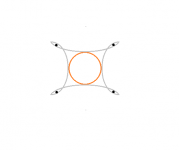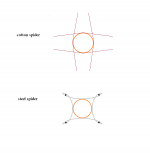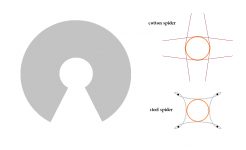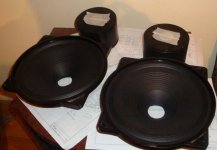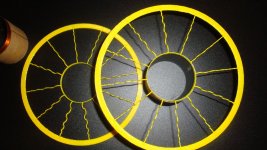... based on this (i wanted to use bend guitar strings)
curved steel strings might be great

did you build the one in the picture ? ... or for inspiration ?
curved steel strings might be great
did you build the one in the picture ? ... or for inspiration ?
oh yes, just inspiration. picture is a creation of Be Yamamura from the 90s. Looks like the exactly set up pressure of circular steel strings from 3 sides could do the centering job well. if the excursion of the diaphragm is minimal, string may not be even attached to the coil former..
... string may not be even attached to the coil former..
but may better be
here is a quick drawing of the curved string idea
Attachments
but may better be
here is a quick drawing of the curved string idea
i imagined a little notch in the coil former rather than a drop of glue but it surely can be attached intelligently.
ad visualisation - yes, something simple. (sharing a screw for 2 strings can make fine tuning harder, but that is just detail )
now im trying to find the right way to stretch the leather surround pripr to glueing to frame, i hope this is the only way (Rullit) http://i767.photobucket.com/albums/xx314/rullit/LR-1/IMG08824.jpg?t=1312225692
or the proven and very simple method ... use fine threads
silk, chinese thread, or just any suitable type sewing thread
mount all strings so they touches the voice coil
allign the voice coil in the gap
then glue all joints between threads and voice coil former
and its fixed
and especially with this type of driver that barely moves, it would be near perfect
silk, chinese thread, or just any suitable type sewing thread
mount all strings so they touches the voice coil
allign the voice coil in the gap
then glue all joints between threads and voice coil former
and its fixed
and especially with this type of driver that barely moves, it would be near perfect
or the proven and very simple method ... use fine threads
silk, chinese thread, or just any suitable type sewing thread
mount all strings so they touches the voice coil
allign the voice coil in the gap
then glue all joints between threads and voice coil former
and its fixed
and especially with this type of driver that barely moves, it would be near perfect
sorry im not getting it .. do you mean adjusting the cone height-wise in the process of glueing the surround to the basket? (while side-wise its done by the shim inserted in the gap)
i can't imagine the treads you mentioned (i'm just beginning with all this)
i can't imagine the treads you mentioned (i'm just beginning with all this)
they replace the spider
as for the height adjustment of voice coil, well ...
Attachments
you really do not want a design that needs adjustments
try imagine poking around 'in there' with a tool
all aspects of ongoing adjusting are simply problems
do it the industrial way, mount it, allign, and glue
if it needs readjustment, rebuild it
as long as we are talking fullrange drivers, with care, training, and experience, I reckon you will be able to improve cheap drivers to achieve maybe 90% of the best available, or maybe even with luck do better than most ... (but that is off topic)
try imagine poking around 'in there' with a tool
all aspects of ongoing adjusting are simply problems
do it the industrial way, mount it, allign, and glue
if it needs readjustment, rebuild it
as long as we are talking fullrange drivers, with care, training, and experience, I reckon you will be able to improve cheap drivers to achieve maybe 90% of the best available, or maybe even with luck do better than most ... (but that is off topic)
Idk man you can only really get so far from improving an existing driver let alone a cheap driver. Though there is no doubt there can be an improvement.you really do not want a design that needs
as long as we are talking fullrange drivers, with care, training, and experience, I reckon you will be able to improve cheap drivers to achieve maybe 90% of the best available, or maybe even with luck do better than most ... (but that is off topic)
Idk man you can only really get so far from improving an existing driver let alone a cheap driver. Though there is no doubt there can be an improvement.
could be much more than just improving it
only use original chassis, magnet system, and voice coil, and change the rest
could be much more than just improving it
only use original chassis, magnet system, and voice coil, and change the rest
this is what i have in my mind for a long time, but it's so rarely mentioned on the web, compared to other audio related activities - i can't find any info on making cones, surrounds, spiders .. just generic commercial recone-stuff. i know i have to learn mostly by myself, but i appreciate anything i find (like this thread, even if it lacks basic since people here are experienced). thanks again and sorry for off-topic.
Like this:Perhaps an ideal solution is to use a helical double-start or triple-start machined spring as a spider replacement. They can be designed for low spring rate in the axial direction, which is nice for getting your desired Fs. At the same time, they can also have high spring rate in the radial direction, which is great for centering. Finally, they have no stiction which is a problem in slide-type assemblies (e.g. Adire Audio Parthenon).
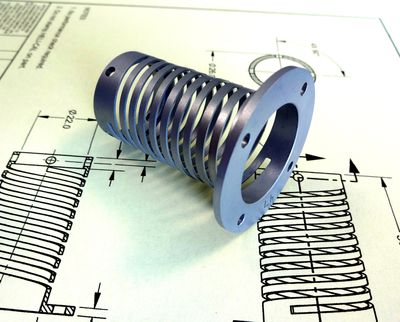
- i can't find any info on making cones ...
a folded piece of paper works fine for a small fullrange cone, and is very well proven too
Attachments
Those spider arrangements look like they create non-linearities from the slippage (which needs the static friction to be broken free first).a folded piece of paper works fine for a small fullrange cone, and is very well proven too
You may find that it is difficult to get the accuracy you want due to the support material that will be built into the design. Take care during the support addition stage and you should be OK.
EDIT: You should remove those sharp contours. They are stress risers.
Nice spider.... but I'm sure it is hard to make, if you make it of plastic I think it will break over time.
I like the fact that the areal is small this will produce less sound and interfere less with the sound that the is cone making. I am still confused to what kind of spider I will be using, I need a very soft one due to the low cone mass.
Here is a picture of my new wizzer, the weight is a bit under 100 micro grams, in fact I can't measure it on my scale sense the resolution is 0,1 gram.
Take care
Of course what i presented are just conceptual renderings. Im discussing the material and 3D printer limitations with the people operating that machinery in order to get what i want.
but may better be
here is a quick drawing of the curved string idea
I like this idea very much.
- Home
- Loudspeakers
- Multi-Way
- Project Ryu - DIY Field Coil Loudspeaker
